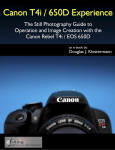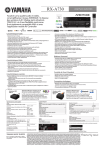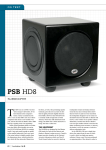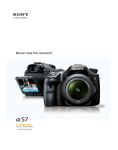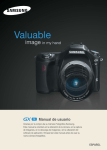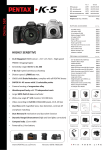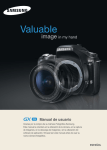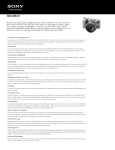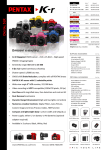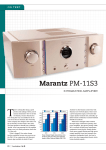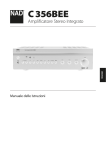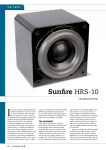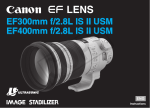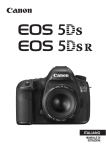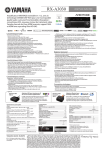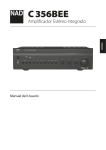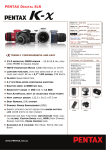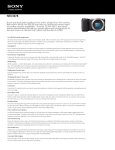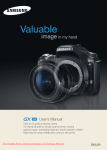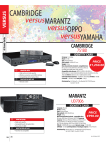Download Nikon D 600 Review
Transcript
ON TRIAL couple of the ‘staples’ for starters – say a 24-70mm f2.8 and a 70-200mm f2.8 – you’re still looking at a reasonable outlay. And yet there is so much going for the bigger sensor, in the end it’s going to be hard to resist. Nikon has been careful to make sure the D600 isn’t a junior D800, but it still brings a high level of features and specifications to a lower price point. We heralded the D800 as the best value D-SLR on the market, but the D600 is giving it a serious run here even if it lacks the superlative performance edge of its big brother. Nikon really doesn’t pull many punches with the D600. It obviously doesn’t have the same ultra high-res sensor as the D800 and it uses mostly earlier generation control systems, but in terms of the total package it’s arguably equally appealing. In fact, for some users the D800 may well be too much camera, especially in terms of the bigger file sizes its generates and the extra demands these subsequently place all the way along the workflow. The leaner D600 may well be a better fit for some applications. Working The Pixels Currently the most affordable D-SLR with a 35mm-sized sensor, the D600 will undoubtedly convince many to move up from the ‘APS-C’ format even if it does involve replacing lenses. The ‘kit’ zoom is Nikon’s ‘FX’ format 24-85mm zoom which, of course, is still a 24-85mm zoom on the D600. One Size Fits All NIKON D600 More affordable D-SLRs with 35mm-sized sensors were always an inevitability, but will they work for pros and, if so, why pay more for a higher end model? Report by Paul Burrows. S o, who’s going to say it first? No matter how happy you might be with your ‘APS-C’ format D-SLR, it’s fair bet you’ve secretly been yearning for a return to the 35mm image size. C’mon, be honest now. Of course, many working photographers happily kissed good-bye to all that mucking around with focal length magnification factors ages ago, courtesy of Nikon’s D3-series and the D70 or Canon’s EOS-1Ds models and, most popularly, the EOS 5D family. A few canny souls latched onto the bargain of the century that was Sony’s A900 and, frankly, once you’re back in the 35mm fold, you never look back. 40 And now, virtually overnight, there are three new D-SLRs with 35mm-sized sensors selling for under $3000. In fact, Nikon’s D600 and its Canon rival, the EOS 6D, are selling at under $2500… and what’s the betting they’ll sneak under $2000 once the initial rush of buyers dies down? Is this the beginning of the end for ‘APS-C’? Well, it’s not quite that straightforward because if you’ve invested a bit in good quality ‘APS-C’ format lenses – and bear in mind this was Nikon’s emphasis for a long time – then you probably won’t want to dump them at a loss. This perhaps is more of a consideration for amateurs, but even if you elect to simply re-equip with a The D600 gets off to a good start with its fully weather-proofed bodyshell which comprises magnesium alloy top and bottom plates, but a GRP front panel. So it’s not quite a full metal jacket, but it’s still at the tougher end of the construction quality scale. And it’s stuffed with higher-end goodies, starting with its 24.7 megapixels (total) CMOS sensor which is a Nikon-ised version of the Sony SLT-A99’s imager. The imaging area is 35.9x24.0 mm so the pixel size is just a shade under six microns which bodes well for performance aspects such as the signal-to-noise ratio and the image dynamic range. In the D600, of course, the sensor is mated with Nikon’s latest-generation ‘Expeed 3’ processor which means colour, sharpness and noise reduction are all dictated by Nikon’s own algorithms and so will be different from the A99’s output. The effective pixel count is 24.3 million, giving a maximum image size of 6016x4016 pixels. RAW files can be processed at 12-bits or 14-bits, compressed or with The main mode dial locks on a setting as does the selector for the drive modes located below it. ON TRIAL lossless compression. The D600 will automatically switch the ‘APS-C’ format when one of Nikon’s ‘DX’ lenses is fitted, cropping the image area to 24x16 mm and dropping the resolution to 10.5 megapixels. The other image sizes offered on both the D800 and D4 aren’t available. The sensitivity range is equivalent to ISO 100 to 6400 (with extensions to ISO 50 and 25,600 at either end). The ‘Expeed 3’ processor enables continuous shooting at up to 5.5 fps (at full resolution) and Full HD video recording at 25 fps progressive-scan (or 24 fps) with MPEG-4/H.264 compression. There are high-quality and normal modes corresponding to 24 Mbps and 12 Mbps respectively. Like both the D4 and D800, the D600 delivers a ‘clean’ uncompressed HD video feed to its HDMI connector and has both a stereo audio input and a stereo output so Nikon is also hoping to maximise its appeal to video makers. It also gets the index marking facility and the time-lapse mode, but it lacks the very handy ‘Power Aperture’ control. The built-in microphone is monaural, but – as is also the case when an optional stereo mic is connected – the recording level can be manually adjusted or set to auto attenuation, and set of level meters appears in the monitor screen. Focus And Exposure In terms of its camera control systems, the D600 isn’t in the same league as the either D800 or the D4, but it hardly slums it either. Autofocusing is via the same 39-point system as used in the D7000, with the capacity to configure the ‘Dynamic-Area’ mode to nine, 21 or the full 39 points, and ‘3D Tracking’. Low light sensitivity extends to EV -1.0 (at ISO 100) which isn’t as good as the D800’s EV -2.0. Nine of the focus points are cross type arrays and the seven most central points still work with lenses as slow as f8.0 (primarily to accommodate users of the 2.0x teleconverter). While the lower end Nikon ‘APS-C’ format D-SLRs have long ago abandoned the built-in autofocusing mode, it’s retained on the D600 even if most of the high-performance Nikkors are now AF-S lenses with their own focusing drives. Exposure control is based on Nikon’s 2016-pixel, RGB-sensitive sensor which drives the ‘3D Colour Matrix Metering II’ multi-zone measurement and the alternative centre-weighted average and spot modes. As on all the higher-end Nikon D-SLRs, the centre-weighted metering has a variable diameter centre spot or can be switched to make fully averaged measurements. The standard set of ‘PASM’ exposure control modes are supplemented with a set of 19 subject/ scene programs which includes, believe it or not, one for ‘Blossom’, as well as settings for high-key and low-key exposure adjustments. The manual exposure overrides comprise an AE lock, up to +/-5.0 EV of compensation and auto bracketing either for available light exposures, flash exposures or a combination of both. The bracketing sequences are limited to either two or three frames. colour temperature can be set manually from 2500 to 10,000 degrees Kelvin. Up to four custom white balance measurements can be made and stored for future recall. White balance bracketing adjustments can be in five-, ten- or 15-mired increments over the amber-to-blue colour range, but only over sequences of two or three frames (unlike the D800 which offers up to nine frames of adjustments). Colour, Contrast And Corrections As far as the image processing functions go, the D600 doesn’t depart much from the D800’s original recipe, starting with a set of six ‘Picture Control’ “On paper the differences look greater than they are in practice and while the D800 undoubtedly has the edge in some areas, the fact that the D600 is around a grand cheaper helps redress the balance.” Like the D800, the D600 has a built-in pop-up flash, but there isn’t a PC terminal to supplement the hotshoe. However, the built-in unit’s repertoire extends to slow speed sync, second curtain sync, manual power adjustment (all the way down to 1/128) and serving as the commander for wireless TTL set-ups. The maximum sync speed is 1/200 second and the full shutter speed range is 30-1/4000 second. Nikon says the shutter assembly has been tested to 150,000 cycles. The white balance control options are pretty close to those offered on the D800, starting with two auto correction modes – one normal and the other designed to maintain warmer tones when shooting under incandescent lighting. The standard automatic correction has a range of 3500 to 8000 degrees Kelvin. There’s a choice of 12 presets for different lighting types, including seven for the various different types of gas-ignition lamps ranging from sodium-vapour at 2700 degrees Kelvin to mercury-vapour at 7200 degrees Kelvin. Fine-tuning of all the presets is possible in fivemired increments across the green-to-magenta and blue-to-amber colour ranges. Alternatively, the presets. These are actually now standard across the Nikon D-SLR line-up with the choice being Standard, Neutral, Vivid, Monochrome, Portrait and Landscape. The colour presets have adjustments for sharpness, contrast, brightness, saturation and hue while the Monochrome preset substitutes the last two with the B&W contrast filters and a selection of toning effects. These extend to nine colours, each with seven levels of density. Each preset also has a ‘Quick Adjust’ option which combines various sets of adjustments. Up to nine modified ‘Picture Controls’ can be created and stored with provisions for each to be named using titles of up to 19 characters in length. Alternatively, custom ‘Picture Controls’ can be created in Nikon’s ViewNX 2 or Capture NX 2 software and loaded into the camera via a memory card. As on the D800, there’s a multi-exposure HDR capture mode which captures two images simultaneously – one underexposed and one overexposed – which are subsequently combined. The degree of exposure variation can be set manually to +/-1.0, 2.0 or 3.0 EV or adjusted automatically based on the brightness range in the scene. The D600 delivers an uncompressed video feed to its HDMI output and has both a stereo audio input and an output. The comprehensive monochrome read-out panel supplements an information display shown in the D600’s LCD monitor screen. Replay function buttons double as short-cut keys to the main capture adjustments for ISO, white balance and image quality. The button with the paintbrush icon accesses the ‘Retouch Menu’ in replay mode or the ‘Picture Control’ presets in the camera’s capture mode. 41 ON TRIAL Additionally, smoothing adjustments (which work on the combined edges) can be set to High, Normal or Low. HDR capture can be set to self-cancel after execution or continue until manually cancelled. The ‘Active D-Lighting’ processing options are the same as on the D800 so there is a choice of Low, Normal, High, Extra High or Auto settings. However, the ADL auto bracketing sequence is again reduced to either two or three shots only (whereas the D800 also has a five-shot setting). Nikon’s ADL processing essentially works like the ‘Shadow/Highlight’ adjustment in Photoshop, and combines exposure and tone curve adjustments to optimise brightness and dynamic range, but without the provision for precise manual control. The ‘Active’ part of the function’s title indicates the corrections are performed at the point of capture (so this additional processing will reduce the continuous shooting speed), but the alternative is to process the image in-camera later, using the ‘D-Lighting’ function available in the D600’s Retouch Menu. This creates a new file and, very helpfully, provides both a preview and a comparison with the original. The D600 also has in-camera correction for lens aberrations. ‘Vignette control’ and ‘Auto Distortion Control’ are selectable from the main Shooting Menu while correction for lateral chromatic aberrations is always applied automatically with JPEG capture. It works by compensating for the differences in the resolving index for each colour wavelength rather than just correcting for any colour fringing at a contrast edge. Consequently, it’s particularly effective at eliminating the chromatic aberrations that occur at the edges of the frame when shooting with older wide-angle lenses. The correction for brightness fall-off can be set to Low, Normal or High while the distortion correction is simply either on or off. Both only work with either D-type or G-type Nikkor lenses. Both high ISO and long exposure noise reduction is provided, the former with four settings – ‘High’, ‘Normal’, ‘Low’ or ‘Off’ – although ‘Off’ doesn’t actually mean off because noise reduction is automatically applied with any of the boosted sensitivity settings. The D600 has the same expanded ‘Retouch Menu’ as the D800 which includes a growing number of special effects such as ‘Fish- eye’, ‘Colour Outline’, ‘Colour Sketch’, ‘Miniature Effect’ and ‘Select Colour’. The D600 also has the same ‘Quick Retouch’ setting which automatically boosts the saturation and contrast with the choice of ‘Low’, ‘Normal’ and ‘High’ settings. The other offerings in the Retouch Menu include straightening, distortion control, perspective control, red-eye correction, adjustments to colour balance (using RGB histograms for guidance), trimming, B&W conversion (with the option of either sepia or cyanotype toning), skylight or warm filter effects, image overlay (for two RAW files with the capacity to balance the exposures as required), resizing, in-camera RAW-to-JPEG conversion and basic movie editing. This involves the simple trimming of the start or end points, or the saving of selected frames as JPEGs. Many of the editing functions for stills are adjustable and, of course, the effects can be previewed. For the in-camera conversion of RAW files to JPEGs the adjustable parameters are displayed alongside the thumbnail image and it’s simply a case of using the camera’s four-way ‘MultiSelector’ control pad to navigate through them and change any settings as desired. The exposure compensation adjustments are reduced to a maximum of +/-2.0 EV. We might have been bedazzled by the D800, but remember that 24 megapixels is still a whole lot of resolution and the D600 puts it all to good use in terms of its image detailing, definition and dynamic range. Memory card bay has dual slots for SD/ SDHC/SDXC types (both with UHS-1 support). The menu system is the same as that used in all Nikon’s current top-end D-SLRs which means it’s logical in its layout and very easy to navigate. 42 The Custom menu provides access to a total of 50 settings. ON TRIAL In The Hand Size-wise, the D600 is quite similar to the ‘APS-C’ format D7000, but it’s closer to the D800 in terms of both the styling and the control layout. The major difference is a return to a main mode dial instead of the D800’s cluster of short-cut keys for ISO, white balance, image quality settings and exposure bracketing set-up. These duties are moved to become alternate functions for the replay buttons on the back panel. The bracketing set-up button moves to the lens mount binnacle. The D600 has the same 8.1 cm LCD monitor screen (with a resolution of 921,600 pixels and an anti-reflection layer) and it also has dual memory card slots, except both are for SD/SDHC/SDXC types (with UHS-1 speed support). The dual card management options include auto ‘overflow’ switching, back-up (i.e. the simultaneous recording of a file to both cards) or the separate recording of either RAW and JPEG files, or still images and video clips. A monochrome LCD read-out panel is retained on the top plate and the optical viewfinder uses a proper glass pentaprism to give approximately 100-degree scene coverage in the ‘35mm’ format. As we’ve now come to largely take for granted from Nikon, the handgrip is exceptionally comfortable and the control ergonomics are largely faultless. It feels right and works intuitively, but the bad news is that it is just different enough to the D800 to make swapping between the two rather less than seamless. The main mode dial locks on its settings as does the drive mode selector located below it (which includes positions for mirror lock-up and quiet shutter release). There’s a dedicated video start/stop button adjacent to the shutter release and, as on the D800, there’s a dedicated live view button which incorporates a switch for selecting the still or video modes. If so desired, however, the shutter release button can be configured for video start/stop. Also lifted straight from the D800 is the simplified AF mode selector – located at the base of the lens mount – which comprises an AF/MF switch and a button in the centre for cycling through the operation and area modes using either the front or rear input wheels. The D600 actually runs on the same EN-EL15 lithium-ion battery pack as the D800 and there’s an optional vertical/battery grip called the MB-D14 which connects via a dedicated terminal in the camera’s baseplate (rather than through the battery compartment) to properly extend the shooting ‘range’. The MB-D14 accepts either a second li-ion pack or six AA-size batteries which fit into a supplied holder. Read All About It The viewfinder display includes illuminating focusing points, AF area frames, a pretty comprehensive set of read-outs and the option of having a framing grid. A level display can also be activated, but this only indicates tilting (or rolling) and not pitching. The eyepiece has a strength adjustment, but no shutter. The monitor screen is protected by a detachable plastic cover so it doesn’t have the toughened faceplate of the higher-end models, but at least Nikon goes to the trouble of providing the protector. The monitor can serve as a comprehensive information display and there’s a choice of either black-on-white or white-on-black schemes (or auto switching between the two depending on the available light levels). However, this information display isn’t a full interactive control screen. Instead, two rows of ‘soft’ buttons arranged along the bottom of the display provide direct access to a smallish selection of capture functions, including the ‘Active D-Lighting’ settings, the noise reduction settings, the colour space settings and the two functionassignable buttons (the depth-of-field preview button and the ‘Fn’ button which is also located on the lens mount). These rows of soft keys aren’t customisable so what you see is what you get, but there are two ‘User Settings’ banks which can be configured as desired and subsequently selected via the main mode dial (as either ‘U1’ or ‘U2’). The menu system is unchanged from what Nikon has been doing for years so the layout is simple, but clean and the basic rule of navigation is click right to go down a level, left to go up. Each section is self-contained, but fully scrollable. The one anomaly is that a couple of items require that you click ‘Done’ before the selected settings will actually be applied so, if you miss this step, you’re left wondering why what you asked to happen actually hasn’t. As is the case on all Nikon D-SLRs, there’s a wide choice of playback/ review screens, including a thumbnail image accompanied by a full set of brightness and RGB histograms and three pages of image data which increases if copyright details are included and/or the optional GPS receiver is fitted. The high- light warning can be cycled through the RGB channels separately. The other playback options include 4/9/72 thumbnail displays, zooming up to 38x and a slide show with variable image display times. The live view screens include a ‘virtual horizon’ dual-axis (i.e. roll and pitch) level display and a framing grid, but – another curiosity – no real-time histogram so one isn’t available when shooting video either. Speed And Performance Like its ‘35mm’ format siblings, the D600 is very much an ‘old school’ D-SLR, but that’s no bad thing in terms of being able to pick the thing up, select whatever settings you want and start shooting. You can fly these things without going near the user’s manual, although it’s worth noting here that the D600’s ‘book of words’ is actually extremely good… it’s about the size of a paperback which means it’s comprehensive without needing to use a 4-point typeface. Both the D600’s AF and AE systems are well proven elsewhere in the Nikon D-SLR stable, although both have been tweaked on this model compared to the earlier versions. The AF is fast and unerringly accurate while the multi-zone metering takes every lighting situation comfortably in its stride and rarely is any manual intervention required for corrective purposes. Of course, this is helped by the fact that the sensor also delivers an exceptionally wide dynamic range so the need to either under- or overexpose to preserve detailing in the highlights or the shadows is much reduced. And the level of crisply defined detailing evident in the D600’s output is exceptional. Living in the shadow of the D800, it’s easy to forget that 24.3 megapixels is still a whole lot of resolution and Nikon knows “The sensor’s imaging area is 35.9x24.0 mm so the pixel size is just a shade under six microns which bodes well for performance aspects such as the signal-to-noise ratio and the image dynamic range.” 43 ON TRIAL how to make each and every one of them work to maximum effect. The maximum quality JPEGs are beautifully sharp with super-smooth tonal gradations and they pretty well stay this way up to ISO 3200. There’s a slight loss of definition at ISO 6400 which then progressively diminishes at each of the expanded sensitivities, but overall the D600 jumps straight into the exclusive little club of high ISO high fliers. RAW capture is better again in terms of both the dynamic range and the low levels of noise. Against the clock, the D600 fired off a sequence of 47 JPEG/large/fine frames in 8.355 seconds which represents a shooting speed of 5.62 fps and that’s slightly better than the quoted speed. We couldn’t quite reach the quoted maximum burst length, but 47 frames is still a very good run. These were then very rapidly written to the SanDisk ExtremePro SDHC UHS-1 memory card. The test image file size was around 12.5 MB which is still comparatively large, but a bit more manageable than the D800’s 16 MB or thereabouts depending on image content. It’s also worth noting that the D600 is at least 1.5 fps faster. The Verdict Having been completely seduced by the mighty D800, we suspected we might find the D600 a bit of a let down and initially it was tempting to keep making comparisons. The thing is though, these comparisons simply revealed that the D600 is actually very impressive in its own right. It’s still extremely well featured, well built and well specced… and it still delivers a huge amount of imaging performance compared to anything else (except, of course, the D800). Throw in the lighter weight body, the much lighter weight price tag and the lighter weight file sizes, and the D600 has just as much going for it as its higher-res sibling. On paper the differences look greater than they are in practice and while the D800 undoubtedly has the edge in some areas (its high ISO performance for starters), the fact that the D600 is around a grand cheaper helps redress the balance. In the end, the D600 is actually its own camera with its own particular set of attributes and it will be more than able to do the job for many photographers. Nikon has been pretty clever at putting some distance between the D600 and D800, but maybe not quite clever enough because it’s quite conceivable that the combination of 24 MP, 5.5 fps and $2400 (or perhaps less) will still win the day. 44 Nikon D600 $2479* * body only, estimated average street price Type: Enthusiast/semi-professional digital SLR with Nikon F (D-type) bayonet lens mount Focusing: Automatic via 39-point wide-area system using phase-detection type CCD sensor with nine cross-type arrays. Focus points may be selected manually or automatically and either as single points or in groups (9/21/39). Points re-orientated for vertical shooting. Auto-area AF mode automatically determines subject type and selects the focus point. One-shot and continuous modes both with a predictive function. 3D Tracking mode. Sensitivity range is EV -1 - 19 (ISO 100). AF assist provided by built-in illuminator. AF micro-adjustment for individual lenses (up to 20).AF assist provided by built-in illuminator. Contrastdetection AF in live view and video modes. Metering: 2016-pixel RGB ‘3D Color Matrix II’, centreweighted average (with variable diameter weighting – 8.0mm, 12mm, 15mm or 20mm), full average, spot (4.0mm/1.5%), and i-TTL flash via 2016-pixel sensor. Metering ranges are; 3D Color Matrix II and C/W average = EV 0 to 20, spot = EV 2 to 20 (f1.4/ISO 100). Exposure Modes: Continuously-variable program with shift, shutter-priority auto, aperture-priority auto, metered manual, i-TTL auto flash and manual flash. 19 subject/ scene modes. Shutter: Electronically-controlled, vertical travel, focal plane type, 30-1/4000 second plus ‘B’. Flash sync up to 1/200 second. Exposure compensation up to +/-5.0 EV in 1/3 or ½ stop increments. Viewfinder: Coverage = 100% vertical/horizontal. Magnification = 0.70x (50mm lens at infinity). LCD displays and LED focus point indicators. Standard focusing screen has AF zones and on-demand grid lines. Eyepiece strength adjustment and built-in shutter provided. Flash: Built-in pop-up unit with GN 12 power (ISO 100). Auto, fill-in, red-eye reduction, front/rear sync and slow speed sync modes. Commander mode for wireless TTL control of compatible external flash units. External flash units connect via hotshoe. Flash compensation range of -3.0 to +1.0 EV in 1/3 or ½ stop increments and flash bracketing (up to three frames). Manual control down to 1/128 of full power. Additional Features: Magnesium alloy/polycarbonate bodyshell sealed against dust and moisture, auto exposure bracketing (over three frames) AE+flash bracketing, depthof-field preview, AE lock, exposure adjustments in either 1/3 or ½ stop increments, variable delay and multi-shot selftimer (two to 20 seconds, up to nine frames), mirror lock-up, quiet shutter mode, audible signals, wired remote control terminal, wireless remote control, 50 custom functions. DIGITAL SECTION Sensor: 24.7 million pixels CMOS with 35.9x24.0 mm area. Sensitivity equivalent to ISO 100-6400 (extendable to ISO 50 and 25,600). Focal Length Increase: None. Formats/Resolution: Three JPEG compression settings (1:4, 1:8 and 1:16), and lossless compressed, compressed or uncompressed RAW files. Three resolution settings at 3:2 aspect ratio; 6016x4016, 4512x3008 and 3008x2008 pixels. Three resolution settings in ‘DX’ format (24x16 mm); 3936x2624, 2944x1968 and 1968x1312 pixels. Additionally, still images can be captured in the movie mode in the ‘FX’ and ‘DX’ formats and the 16:9 aspect ratio, again at three resolution settings. RAW (NEF) images are captured at 6016x4016 pixels, in either 36-bit or 42-bit RGB colour, and either lossless compressed or compressed. RAW+JPEG capture is possible (with all JPEG compression levels). Video Recording: Full HD = 1920x1080 pixels at 25 or 24 fps (PAL, progressive) and 16:9 aspect ratio. HD = 1280x720 pixels at 50 or 25 fps (progressive) and 16:9 aspect ratio. MPEG 4 AVC/H .264 compression. Mono sound recording with auto/manual adjustable levels. Stereo microphone input and headphone output provided. Clip duration limited to 29 minutes and 59 seconds at normal quality (12 Mbps) up to 20 minutes at high quality (24 Mbps). File size limit is 4.0 GB. Video Features: Index marking, time lapse recording, auto flicker detection, uncompressed 8-bit RAW data output via HDMI connection. Recording Media: Two slots for SD/SDHC/SDXC (UHS-1 compliant) memory cards. Overflow, Backup and RAW Primary-JPEG Secondary file management modes. Continuous Shooting: Up to 57 frames at 5.5 fps in JPEG/large/fine mode, up to 16 frames in RAW mode (14bit, lossless compressed). Low speed continuous shooting mode can be set from 1.0 to 5.0 fps. Up to 100 JPEG/large/ fine frames at 5.5 fps is possible when shooting in the ‘DX’ format. White Balance: TTL measurements using the 2016-pixels RGB metering sensor. Auto/manual control with 12 presets and four custom settings. White balance fine-tuning available for AWB and all presets plus manual colour temperature setting (2500-10,000 degrees Kelvin) and white balance bracketing (up to three frames). Warm AWB setting maintains a warmer hue under incandescent lighting. Interfaces: USB 2.0, HDMI output (Type C), 3.5mm stereo audio input, 3.5mm stereo audio output, accessory terminal. Additional Digital Features: Active sensor cleaning, dual-axis ‘virtual horizon’ display, live view functions (with contrast-detection AF), 8.1 cm LCD monitor (921,600 pixels resolution) with histogram displays (brightness and/or RGB channels) and highlight alert; ‘Active D-Lighting’ contrast control (Auto, Low, Normal, High, Extra High), ADL bracketing (up to three frames), six ‘Picture Control’ presets (Standard, Neutral, Vivid, Monochrome, Portrait, Landscape), adjustable ‘Picture Control’ parameters (Sharpening, Contrast, Brightness, Saturation, Hue), B&W filters and toning effects, nine user-defined ‘Picture Control’ modes, multiple exposure facility (up to three frames with Auto Gain), intervalometer, HDR dual-shot capture (Smoothing: High/Normal/Low, Exposure Differential: 1/2/3 EV or Auto), sRGB and Adobe RGB colour spaces, long exposure noise reduction (Off, On), high ISO noise reduction (Off, Low, Normal, High), auto ISO with auto minimum shutter speed control, Auto Distortion Control (Off, On), Vignette Control (Off, Low, Normal, High), image comments input (up to 36 characters), auto image orientation, adjustable image display time, slide show, 4/9/72 thumbnail displays, playback zoom (up to 38x in ‘FX’ format), ‘Retouch Menu’ for in-camera editing (D-Lighting, Red-Eye Correction, Trim, Monochrome, Filter Effects, Colour Balance, Image Overlay, RAW Processing, Resize, Quick Retouch, Straighten, Distortion Control, Fish-Eye, Colour Outline, Colour Sketch, Perspective Control, Miniature Effect, Selective Colour, Edit Movie, Side-By-Side Comparison). May be fitted with optional Wireless Mobile Adapter WU-1b and GP-1 GPS receiver. Power: One 7.0 volt, 1900 mAh rechargeable lithium-ion battery pack (EN-EL15 type). Optional MB-D14 battery grip accepts one EN-EL15 li-ion pack or six AA-size batteries (alkaline, NiMH or lithium). Dimensions (WxHxD): Body only = 141.0x113.0x82.0 mm. Weight: Body only = 760 grams (without battery pack or memory card). Price: Body only = $2479 (estimated average street price). Distributor: Nikon Australia Pty Ltd, telephone 1300 366 499 or visit www.nikon.com.au $7.95 NZ$9.90 Volume 69 Number 6 A L L T H E B E S T F R O M T H I S Y E A R ’ S Head On Festival VAILABL T’S A E IN HA W Studio Flash Power Packs Getting To Grips With Nikon’s AF 800mm Supertelephoto SHOW REPORT High End Munich AUSTRALIA’S No.1 AV GUIDE ALSO REVIEWED Aug/Sept 2013 September/October 2013 NAD C356BEE Best budget amplifier? ISSUE #26/5 $8.95 NZ$10.99 DUAL VALVES! WOOFER WORLD IN SSV WAGON THE HIGH-END ALPINE’S DDLINEAR & PIONEER’S AVIC LG Panasonic Samsung Sony Plasma LED-LCD 4K UHD 65-inch 55-inch CHOOSE YOUR NEW TV! SHOOTING STAR VW IN ORION CONSTELLA TION FULL REVIEWS OF THE BIGSCREEN BRANDS YAMAHA’S ULTIMATE AVENTAGE EXCLUSIVE TEST OF THE A5000 PRE-POWER A DS CANE TO IN 3D! 100% AUSTRALIAN MSB Sig. DAC IV Plus Hand-made heaven Studio 590 bi-radial horn is JBL’s best yet… Horn Power! TRAVEL PHOTOGRAPHY MAKE EVERY SHOT A WINNER 45 NZ $10.99 WONDROUS WAGON WHEELS 5#2013 5#2 5#20 0 D-SLR VIDEO MAKER – EVERYTHING YOU’LL EVER NEED TO KNOW Sony SS-NA2ES Amazing achievement! 300B or KT88? Full review and test of AudioSpace’s innovative amplifier... $8.50 /// NZ $10.99 T H E L AT E S T M O B I L E E L E C T R O N I C S T R E N D S & T E C H N I Q U E S Usher Audio Diamond tweeter sings… Jul/Aug 2013 A$8.95 NZ$10.99 AVHUB.COM.AU CT 2013 $8.50 LOCATION REPORT – MOTOREX 2013 NIKON D7100 FIRST LOOK! ALSO IN THIS ISSUE : CANON EOS 700D







